First Annual Progress Report on Accessibility at Fisheries and Oceans Canada 2023
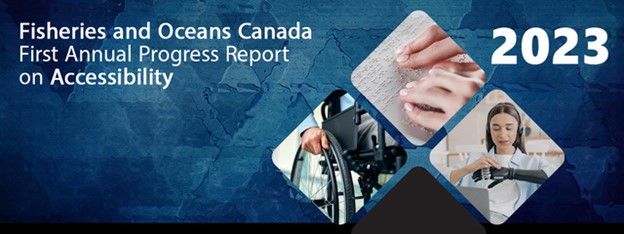
On this page
- General
- Introduction
- Accessibility at DFO
- Progress on implementing the departmental Accessibility Action Plan
- Consultations
- Feedback
- Conclusions and lessons learned
- Annex 1: Progress towards the specific goals of the Accessibility Action Plan 2022-2025
- Annex 2: Information about the kind of barriers reported through the feedback process and through other channels
- Annex 3: Simple markers of progress on accessibility
General
Executive summary
This document, prepared in accordance with the Accessible Canada Act, reports on progress towards the goals outlined in the Fisheries and Oceans Canada’s (DFO) Accessibility Action Plan. In collaboration with employees of the organization, particularly those with lived experiences in the area of accessibility, our primary achievements in this first year have been in establishing the basis to support, measure, and report on activities across the department.
For example, we:
- established a forum for ongoing and meaningful dialogue with employees
- established the departmental Accessibility Secretariat
- proposed a governance framework for coordinating accessibility-related work
- developed a framework for carrying out the systematic assessment of our programs to identify barriers
- set up quarterly reporting and created an annual departmental questionnaire so we can measure progress
- created a quarterly dashboard for senior management to track progress frequently throughout the year
Similarly, sectors of the department who are responsible for specific goals of the plan have laid the foundation for achieving those goals.
For example, we:
- developed a Real Property action plan to proactively look for barriers at DFO custodial facilities
- created a user experience unit to research, design, and test accessible digital products and services
This report includes information about the feedback received, barriers reported, and what the department is doing with this information.
As an organization, we have retained several lessons from this first year’s experiences, for example:
- the lived experiences of employees should be shared so that we may determine collectively which actions to prioritize, recognizing that some barriers are systemic and require several stakeholders to work together to eliminate
- timely accommodation for persons with disabilities is much needed, and is key to driving inclusion efforts
Introduction
Purpose
This report summarizes progress towards the goals outlined in DFO’s Accessibility Action Plan. The plan was made to identify and address accessibility issues, and remove barriers to persons with disabilities (PwD) in these important areas:
- employment
- the built environment
- information and communication technologies
- communication, other than information and communication technologies
- the procurement of goods, services, and facilities
- the design and delivery of programs and services
- transportation
In our first year, in partnership with key stakeholders including our community of persons with disabilities, the main objectives have been:
- to establish the governance and internal capacity to support the implementation of the Accessibility Action Plan
- to establish key actions that will drive accessibility outcomes
- to establish baseline data on which to measure progress
- to ensure that all sectors and regions within DFO are aware of the goals of the plan
- to develop guidance, tracking, and reporting mechanisms so that sectors and regions have the tools and framework to implement the strategies outlined in the plan
Definitions of terms
Definitions of terms used in this report can be found in the Glossary of the Accessibility Strategy for the Public Service of Canada.
Contact information for feedback
The Director General of Workforce Development and Inclusion is designated to receive feedback on behalf of DFO and the Canadian Coast Guard. The Accessibility Secretariat tracks all feedback and responds to all non-anonymous accessibility-related concerns and feedback.
Feedback on barriers encountered at DFO, the Accessibility Action Plan 2022-2025 or the First Annual Report on Accessibility at Fisheries and Oceans Canada 2023 can be shared in the following ways:
- DFO.AccessibilitySecretariat-SecretariatdelAccessibilite.MPO@dfo-mpo.gc.ca
- accessibility feedback form
- toll-free: 1-866-266-6603 (8 am to 8 pm EST), Monday to Friday excluding statutory holidays
- video relay service (American Sign Language [ASL] or langue des signes québécoise [LSQ])
- teletypewriter (TTY) at: 1-800-465-7735
- mail:
Accessibility Secretariat
Fisheries and Oceans Canada
200 Kent Street
6th Floor
Ottawa ON K1A 0E6
Alternate formats
You can request an alternate version of our progress report, Accessibility Action Plan, or our feedback process by email at DFO.Publications.MPO@dfo-mpo.gc.ca or telephone at 613-993-0999.
Formats available:
- large print (larger and clearer font)
- braille (a system of raised dots that people who are blind or who have low vision can read with their fingers)
- audio (a recording of someone reading the text out loud)
- electronic formats that are compatible with adaptive technology
Accessibility at DFO
The Accessibility Secretariat
DFO created an Accessibility Secretariat in January 2023. The secretariat is responsible for:
- creating the general guidance, framework, and reporting tools required for the department to carry out the plan, and report on accessibility at DFO
- working with the departmental accessibility champions as well as the grassroots Accessibility Network at DFO to launch efforts towards creating a culture of inclusion
- receiving and tracking feedback about barriers at DFO, on behalf of the Director General, Workforce Development and Inclusion, who is appointed to receive feedback, and the activities undertaken to remove them
The Accessibility Network
DFO has had a volunteer network of employees with disabilities and their allies since 2017. The network:
- raises awareness and addresses issues related to accessibility in the workplace
- provides feedback through consultations
- brings accessibility concerns to management meetings through the accessibility champions
- promotes a sense of community and involvement
- serves as a forum to exchange ideas and find solutions to accessibility challenges
The Accessibility Secretariat and the network work closely together to drive and support actions and content created to promote accessibility at DFO.
The accessibility champions
DFO currently has two co-champions, Supriya Edwards, Assistant Deputy Minister, People and Culture, and Marc-André Meunier, Assistant Commissioner, Central region, Canadian Coast Guard, who:
- lead on breaking down barriers, promoting the rights of persons with disabilities, and advancing the actions in our Accessibility Action Plan
- provide support and guidance, and promote and represent the network in senior management meetings within the department and interdepartmentally
- promote and participate in events, training, and awareness sessions around accessibility
We wish to recognize the work of the outgoing accessibility champion and Commissioner of the Canadian Coast Guard, Mario Pelletier, who completed his tenure as accessibility champion in 2022 to 2023, and who led by publicly sharing his own experience of disability.
Regional efforts to promote accessibility
In addition to specific departmental goals under the plan, regional efforts made towards promoting accessibility continue, and best practices promoted across the organization.
Examples of work done in the regions include:
- training in the Newfoundland and Labrador region to establish a diverse pool of staffing board members, aimed at creating more inclusive assessment boards in the hiring process
- collaborated with ‘Live-Work-Play’ to identify qualified candidates who are persons with disabilities and match them with positions at DFO
- leveraged an accessibility checklist to ensure documents at the Canadian Coast Guard College are accessible
Persons with disabilities (PwD) at DFO
Based on data from the departmental Human Resources Management System (HRMS) and the Public Service Employment Survey (PSES), we track and monitor representation of PwD at DFO.
Representation at DFO has improved over the past year
In 2022 to 2023, 4.9% of employees at DFO self-identified as PwD, as compared to 4.3% in 2021 to 2022.
Note that these numbers are likely higher in reality as more than half of survey respondents within DFO who said they were PwD reported that they hadn’t self-identified as PwD and therefore wouldn’t be included in the numbers taken from the Human Resource Management System.
The workforce availability in 2022 to 2023 was 8.3%, resulting in a gap in representation of 3.5% at DFO. In other words, the department has a gap of 457 PwD employees (Source: DFO Human Resources Management System).

Figure 1 - Text version
Number of employees who are persons with disabilities:
- 2020 to 2021: 555
- 2021 to 2022: 595
- 2022 to 2023: 722
- Workforce availability1 in 2022 to 2023: 1,179
1 Number of PwD who would be employed at DFO if the rate of employment matched how many PwD are available in the general Canadian workforce.
Hiring of persons with disabilities at DFO
In 2022 to 2023, the percentage of new hires who are PwD was 5.1%, compared to 4.1% in 2021 to 2022 and 1.6% in 2020 to 2021. Source: DFO Human Resources Management System.

Figure 2 - Text version
Percentage of new hires who are PwD:
- 2020 to 2021: 1.6%
- 2021 to 2022: 4.1%
- 2022 to 2023: 5.1%
Promotion of persons with disabilities at DFO
In 2022 to 2023, 10% of PwD received promotions compared with 15% of the general population. Source: DFO Human Resources Management System.
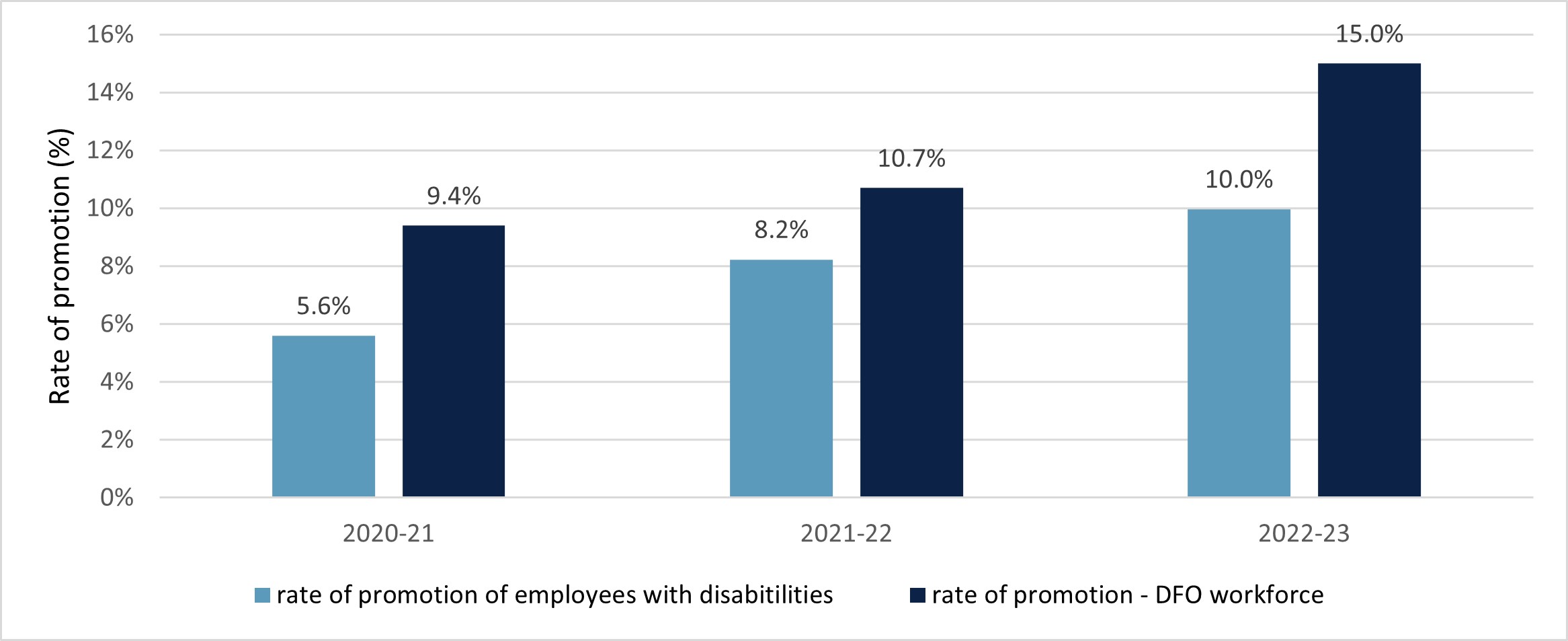
Figure 3 - Text version
| - | 2020 to 2021 | 2021 to 2022 | 2022 to 2023 |
|---|---|---|---|
| Number of PwD promoted as a percentage of the total number of PwD employed | 5.6% | 8.2% | 10.0% |
| Number of employees promoted as a percentage of the total number of employees | 9.4% | 10.7% | 15.0% |
Harassment and discrimination of persons with disabilities at DFO
In 2022, 20% of PwD at DFO indicated they were victims of harassment on the job compared to 11% of persons without a disability. In 2020, 30% of PwD reported harassment.
In 2022, 18% of PwD at DFO indicated they were victims of discrimination on the job compared to 6% of persons without a disability. This is slightly worse than in 2020, when 16% of PwD reported discrimination. Source: Public Service Employment Survey.
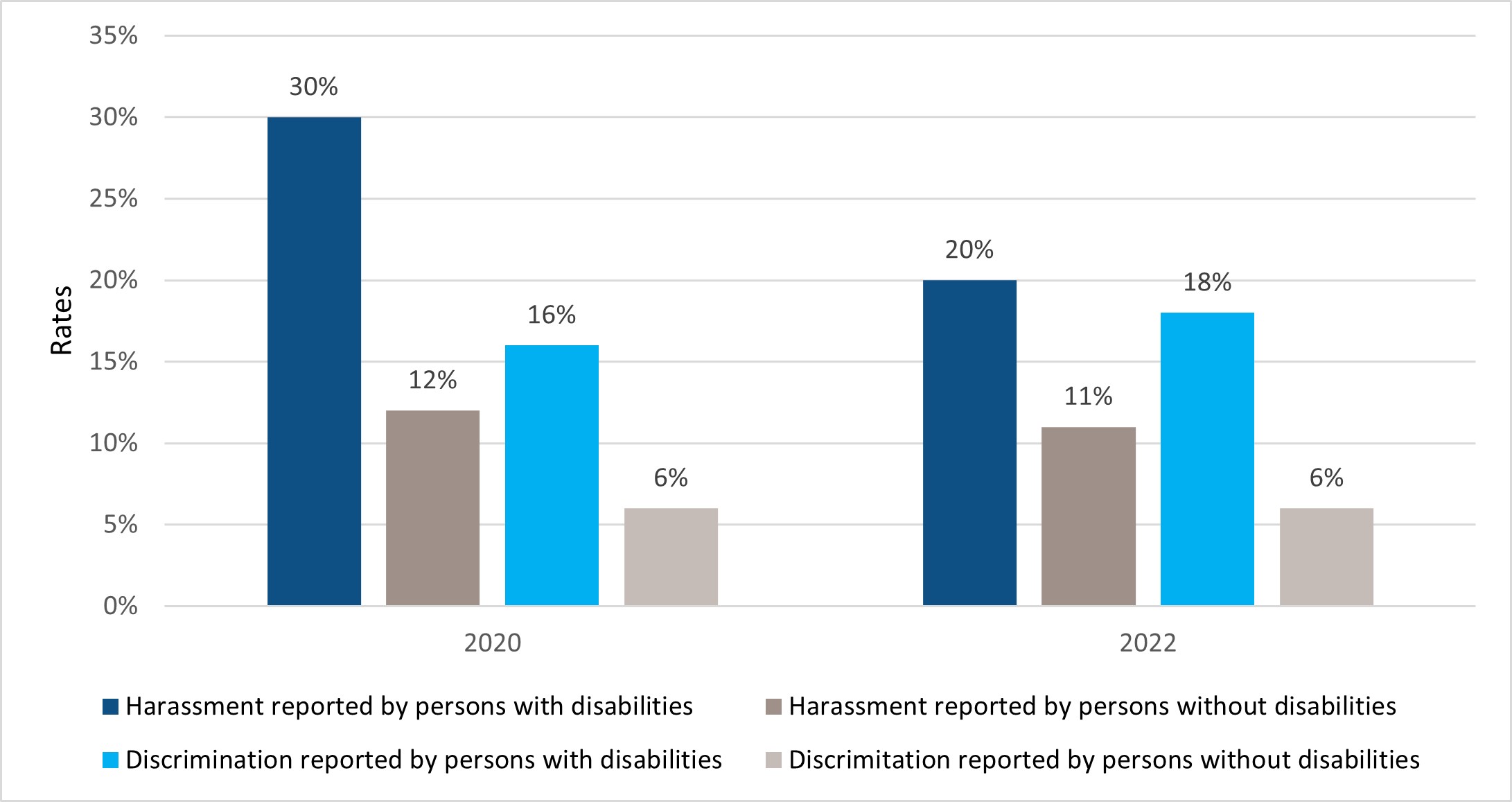
Figure 4 - Text version
| - | 2021 | 2022 |
|---|---|---|
| Proportion of PwD at DFO reporting harassment | 30% | 20% |
| Proportion of DFO employees without disabilities reporting harassment | 12% | 11% |
| Proportion of PwD at DFO reporting discrimination | 16% | 18% |
| Proportion of DFO employees without disabilities reporting discrimination | 6% | 6% |
Progress on implementing the departmental Accessibility Action Plan
Governance
Major accomplishments
To ensure the implementation of the Accessibility Action Plan at DFO, we:
- established ongoing consultation mechanisms with stakeholders such as PwD, functional leads, unions, etc.
- established the Accessibility Secretariat to promote, support, and track the implementation of the departmental Accessibility Action Plan
- consulted with sectors and regions for the creation of a departmental advisory committee on accessibility
- created a system to report on our progress every three months
- developed tools to track and report to the Deputy Minister around progress
- developed a Guide to Applying the Accessibility Lens to Policies, Guidelines, Programs and Services (available only on the DFO network) to provide instructions for performing the accessibility assessments outlined in the plan
Next year
DFO will set up an advisory committee including sectoral and regional accessibility advocates to provide subject matter expertise and coordination. These will help review all the department's policies, guidelines, services, and programs, with support from the Accessibility Secretariat. The evaluation of all departmental policies, guidelines, services, and programs will also begin. Consultation with networks and bargaining agents will continue to ensure actions taken are appropriate and properly prioritized.
Culture
Snapshot of 2022 to 2023
Through the first annual DFO Accessibility Questionnaire carried out in 2023, and the 2022 Public Service Employment Survey (PSES), we collected the following baseline data for comparison in future years.
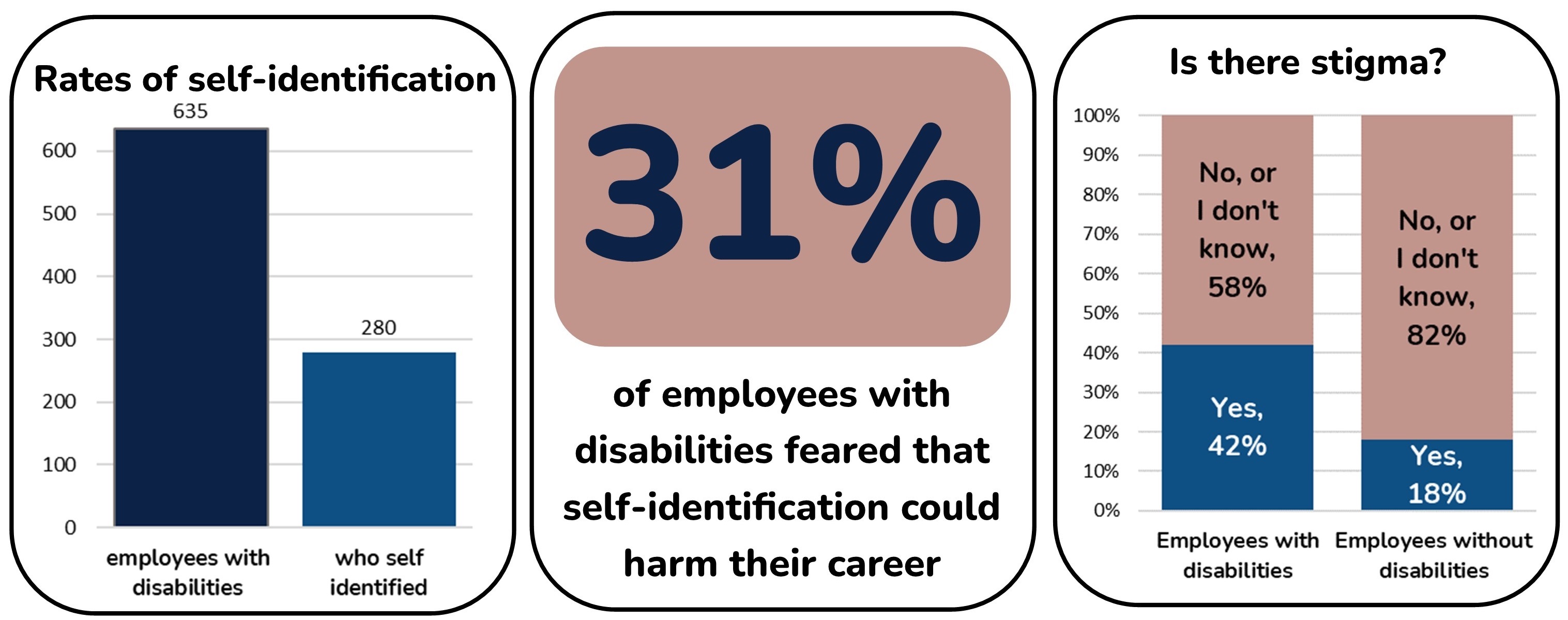
Rates of self-identification include employees submitting in the MyGCHR application (a human resources product) plus those submitting paper forms.
Survey findings
- More than half of employees who completed the questionnaire who said they were PwD didn’t self-identify:
- 635 total number of PwD reporting in the questionnaire
- 355 did not self-identify
- 280 self-identified
- Negative impact:
- 56% of the 355 PwD who did not self-identify chose not to because they feared that it would negatively impact their career. This represents 31% of all PwD who completed the questionnaire
- Stigma:
- 42% of employees who identified as PwD reported that they feel that there is a stigma associated with disability within the department, compared to 18% of employees without disabilities (first annual DFO Accessibility Questionnaire)
- 56% of employees responding to the first annual DFO Accessibility Questionnaire who identified as PwD have reported that they have not self-identified
- managers’ attitudes toward providing accommodations were a significant theme in the feedback
Major accomplishments
To improve awareness, knowledge, and inclusion with respect to accessibility:
- the Accessibility at DFO intranet site was launched providing accessibility-related information such as:
- an accessibility knowledge centre
- best practices, services, and tools
- information on accessibility-related communities and events
- recognition days for various disabilities were jointly promoted and the celebration of National AccessAbility week included educational events such as learning the basic elements of sign language
- DFO contributed to the government-wide celebration of International Day of Persons with Disabilities, led this year by Innovation, Science and Economic Development
- mandatory accessibility training was implemented to provide all employees with the knowledge and skills to support inclusion
- the Accessibility Secretariat has created a thriving community in Viva Engage, which includes 184 individuals who share a commitment to accessibility
- communications strategies and products were launched to support engagement by the departmental accessibility champions
- the former accessibility champion led by example by sharing his experiences with disability, and by doing so, impacted direction and engagement within the department
Next year
The new self-identification form and platform, expected to be launched by Treasury Board Secretariat in the near future, will be promoted. DFO continues to seek advice from the Accessibility Network to implement solutions towards improving the rate of self-ID for PwD. Privacy around the use of the data will remain central.
Employment
Snapshot of 2022 to 2023
Through the first annual DFO Accessibility Questionnaire implemented in May of 2023, and the 2022 Public Service Employment Survey (PSES), we collected the following baseline data for comparison in future years.
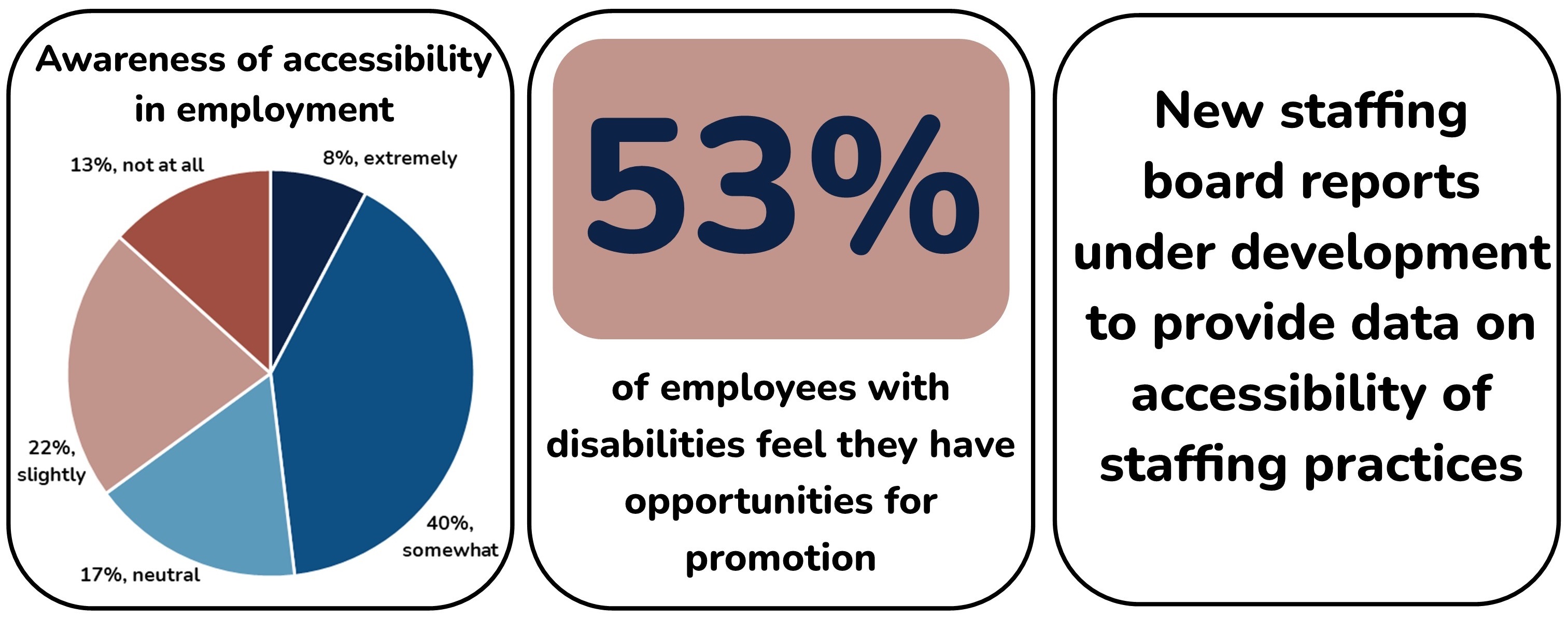
Survey findings
- Awareness of accessibility in employment:
- 8% extremely aware
- 40% somewhat aware
- 17% neutral
- 22% slightly aware
- 13% not at all aware
- Promotion:
- 53% of DFO employees who identified as PwD reported that they believe they have opportunities for promotion within the department given their education, skills, and experience compared to 58% for all employees
- Impact on employees:
- 12% of employees who identify as PwD reported that they have been negatively affected by accessibility or accommodation issues in their career progression over the last 12 months
- persons with disabilities (PwD) are about 10% less likely to believe that they are getting support for their career growth and chances for promotions
- 12% of employees who identify as having a disability reported in the PSES that they feel accessibility or accommodation issues have caused work-related stress compared to 14% in 2021
Major accomplishments
The gap between the representation of persons with disabilities at DFO and the workforce availability has fallen from 521 to 457 individuals.
Mandatory training on inclusive hiring practices was introduced and promoted to all supervisors, managers, executives, and staffing advisors.
To increase employment opportunities for PwD at DFO and contribute to the goal of hiring 5000 PwD in the federal public service by 2025:
- we participated in the Recruitment of Policy Leaders program which places importance on inclusivity, with a specific focus on attracting PwD, and DFO's Deputy Minister is the current champion of this program
- we conducted recruitment drives targeting Employment Equity, Diversity and Inclusion (EEDI) candidates, including persons with disabilities (for example, All Hands on Deck, and All Hands on Science)
To ensure opportunities for career development for persons with disabilities:
- DFO participates in the Mentorship Plus Learning Lab - Sponsorship Program, dedicated to helping employees at the EX-01 and EX minus 1 levels who self-identify as part of equity-seeking groups, including PwD, to help them advance in their careers
- as of March 2023, DFO has 4 participants in the program who self-identify as persons with disabilities
- the number of Talent Management Plans for PwD has increased by 150% in 2022
See Annex 1 for progress towards the specific goals related to employment outlined in the Accessibility Action Plan.
Next year
- Determine how accessible our hiring practices are by creating new staffing board reports
- Continue to collaborate with the Accessibility Network to eliminate barriers to development and promotion
- Support managers in hiring PwD by streamlining processes for appointing PwD using pools and inventories
Built environment
Snapshot of 2022 to 2023
Through the first annual DFO Accessibility Questionnaire implemented in 2023, the 2022 Public Service Employment Survey (PSES), and information from those responsible for the built environment at DFO, we collected the following baseline data for comparison in future years.
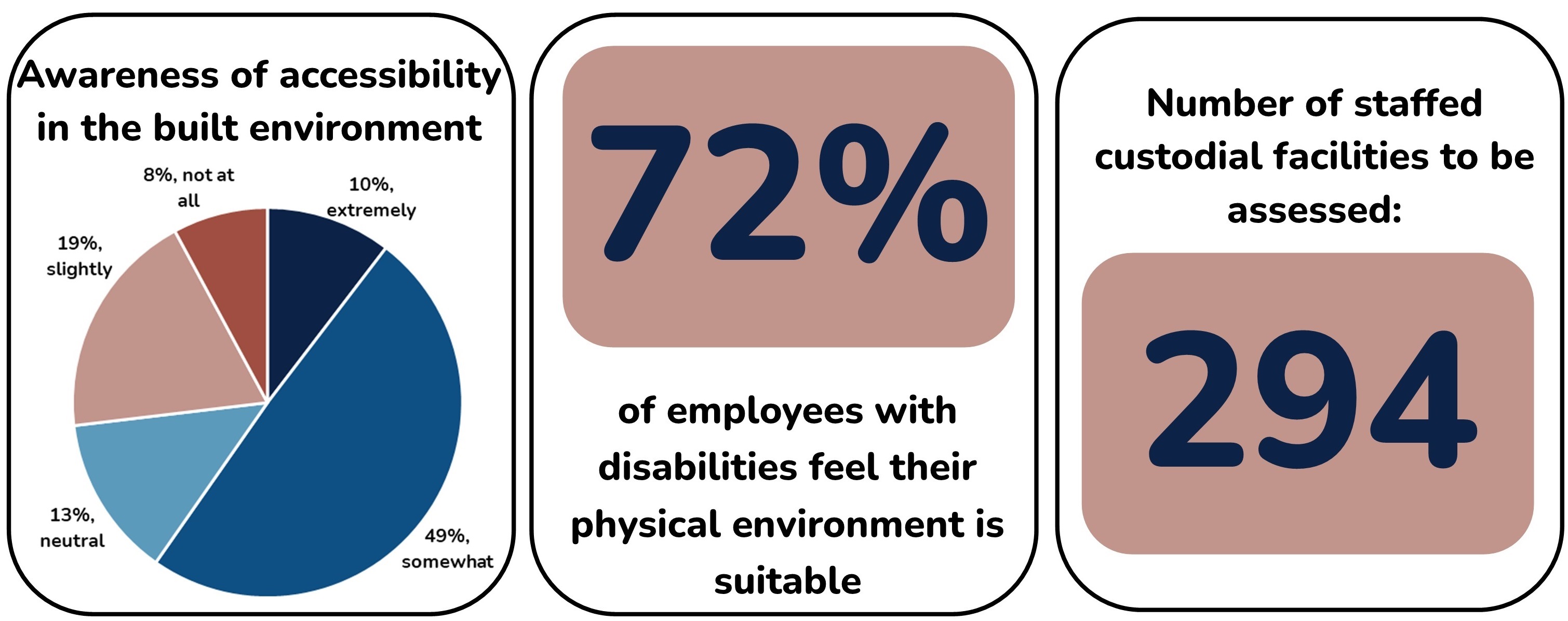
Survey findings
- Awareness of accessibility in the built environment:
- 10% extremely aware
- 49% somewhat aware
- 13% neutral
- 19% slightly
- 8% not at all
- Physical environment findings:
- 72% of DFO employees who identified as persons with disabilities reported that their physical environment is suitable for their job needs, as compared to 80% of the DFO general population
- 18% of the reported workplace barriers were related to a physical barrier
- 294 facilities require assessment for accessibility
Major accomplishments
To address barriers in the built environment:
- a Real Property accessibility action plan has been approved to carry out the activities outlined in the departmental Accessibility Action Plan including actively checking how accessible our facilities are, especially those that are staffed and owned by DFO
- through Fleet procurement, the Canadian Coast Guard is continuing to carry out equity best practices with its ship designs
- mandatory training on Accessibility in the Built Environment was introduced to all employees responsible for program and service design and delivery to increase awareness about accessibility in the built environment
See Annex 1 for progress towards the specific goals related to the built environment outlined in the Accessibility Action Plan.
Next year
- DFO will start an accessibility assessment of the built environment including public-facing spaces to identify how the department can be more accessible and inclusive
- DFO will update built environment policies, procedures, guidelines, programs, and services to adhere to the Accessible Canada Act, and be written with accessibility in mind
- Accessibility in the built environment information sessions will be available across the department
Information and communication technologies (ICT)
Snapshot of 2022 to 2023
Through the first annual DFO Accessibility Questionnaire implemented in 2023, the 2022 Public Service Employment Survey (PSES), and the program responsible for accommodations, we collected the following baseline data for comparison in future years.
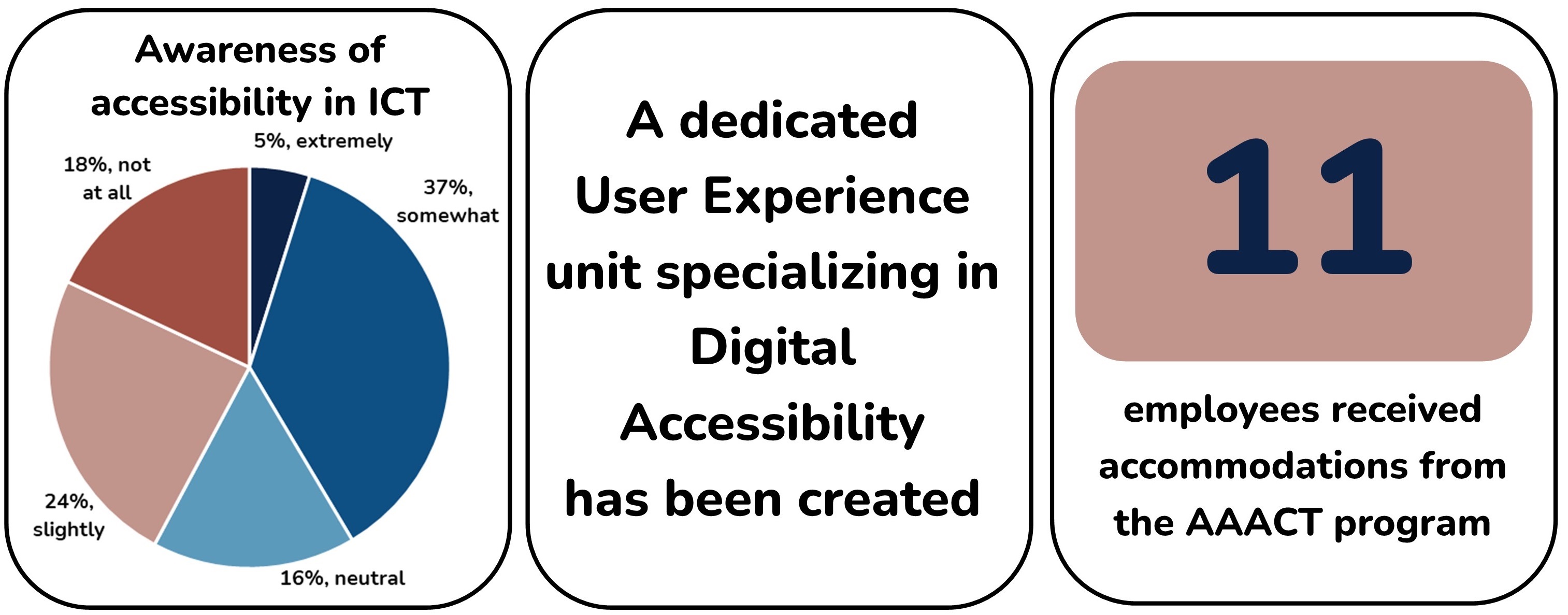
Survey findings
- Awareness of accessibility in information and communication technologies:
- 5% extremely aware
- 37% somewhat aware
- 16% neutral
- 24% slightly aware
- 18% not at all aware
- Accessibility of work tools:
- 12% of employees who self-identified as persons with disabilities (PwD) reported difficulty accessing their work tools or network (for example, work email, work device, ergonomic equipment) as compared to 9% of those without disabilities
- Accessibility, Accommodation and Adaptive Computer Technology (AAACT) program:
- 11 PwD received accommodations in partnership with AAACT program
Major accomplishments
To support the availability of accessible ICT required to work efficiently, DFO created a dedicated User Experience (UX) unit specializing in digital accessibility to research, design, and test digital products with accessibility in mind. The team makes sure that digital products and services are easy to use for everyone, especially PwD. To date, the UX team has tested the following for accessibility: the Enterprise Data Hub, the Mental Health Support Launchpad, and the Registry for External Science Experts.
To increase the knowledge of our information technology (IT) workforce in the area of adaptive technology, ongoing learning is planned within the sector with emphasis around the importance of involving a diverse group of people in the research process when creating products. This goal is to ensure IT remains abreast of emerging tools and technology, as well as ensuring DFO products are naturally designed to be accessible to everyone. In addition, training on “Procuring Accessible Information and Communication Technologies” is mandatory for all employees working in IT.
See Annex 1 for progress towards the specific goals related to information and communications technologies outlined in the Accessibility Action Plan.
Next year
With input from the Accessibility Network, coupled with industry tools and information, DFO will host information sessions, guiding the organization in how to ensure the accessibility of information and communication technologies (ICT). These sessions are meant to help all employees learn about the importance of accessibility in ICT.
Communication (other than information and communication technologies)
Snapshot of 2022 to 2023
Through the first annual DFO Accessibility Questionnaire implemented in 2023, the 2022 Public Service Employment Survey (PSES), and the program responsible for communications, we collected the following baseline data for comparison in future years.
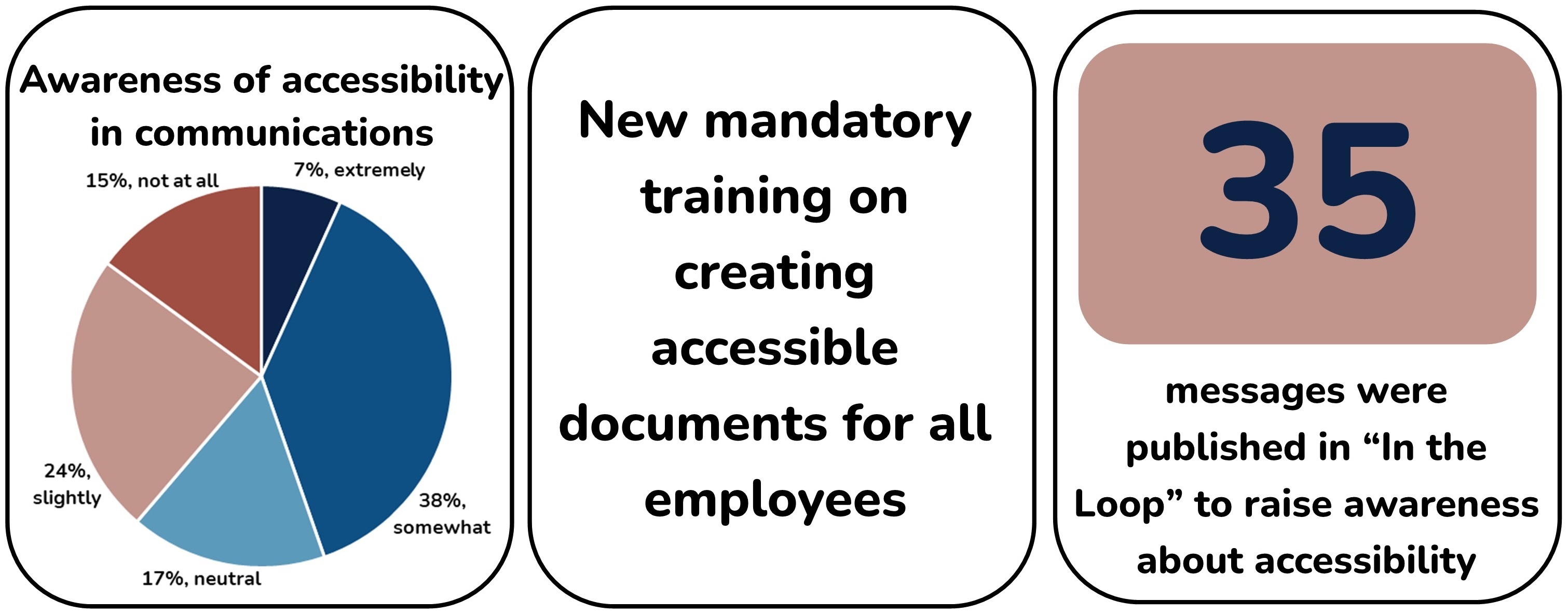
Survey findings
- Awareness of accessibility in communication, other than information and communication technologies:
- 7% extremely aware
- 38% somewhat aware
- 17% neutral
- 24% slightly aware
- 15% not at all aware
- Stigma:
- 42% of employees who identified as having disabilities in the DFO Accessibility Questionnaire reported that they feel that there is a stigma associated with disability within the department, compared to 18% of employees without disabilities
- 35 messages were published in In the Loop, an internal employee communication product, to dispel stigma and raise awareness about disability
Major accomplishments
To overcome the general lack of knowledge on how to create accessible documents and communications:
- DFO created general communication guidance for employees and management to create communication products which meet accessibility criteria, and shared the guidance through internal communication channels
- training on creating accessible documents was identified and made mandatory for all employees
- 35 internal messages were published to raise awareness about accessibility (via In the Loop, an internal employee communication product)
To ensure that communications products are accessible:
- an action plan for ensuring the accessibility of web content has been developed
- high level audits of DFO internet sites are complete and all content posted on internet sites in 2023 to 2024 to fully meet accessibility standards
To reduce stigma associated with disabilities:
- an accessibility campaign to educate and inspire a culture change within the department was started
- National AccessAbility week was celebrated by sharing information and organizing events that helped people learn about various disabilities
- the GC Workplace Accessibility Passport was promoted throughout the department through various communications channels
See Annex 1 for progress towards the specific goals related to communication, other than information and communication technologies, outlined in the Accessibility Action Plan.
Next year
DFO will continue promoting the GC Workplace Accessibility Passport and will continue to work with stakeholders to ensure continued communication around accessibility, as well as to ensure the accessibility of communication products overall.
Procurement of goods, services and facilities
Snapshot of 2022 to 2023
No feedback received during 2023 related to barriers at DFO was related to procurement.
The ability to report on rates of accessibility for procurement documents has not yet been developed.
Major accomplishments
To address lack of knowledge in accessible procurement of goods, services, and facilities, training has been updated for procurement officers.
To increase the accessibility of documents and procedures in procurement an internal intake form has been developed to ensure that a record for accessibility was provided and justification for non-inclusion is on file.
See Annex 1 for progress towards the specific goals related to procurement of goods, services, and facilities outlined in the Accessibility Action Plan.
Next year
An accessibility toolkit for staff involved in procurement will be launched in the first months of 2024. The toolkit will ensure that procurement tools are accessible and will provide information on how to assess products and services for accessibility.
Design and delivery of programs and services
Snapshot of 2022 to 2023
Through the first annual DFO Accessibility Questionnaire implemented in 2023, and the 2022 Public Service Employment Survey (PSES), we collected the following baseline data for comparison in future years.
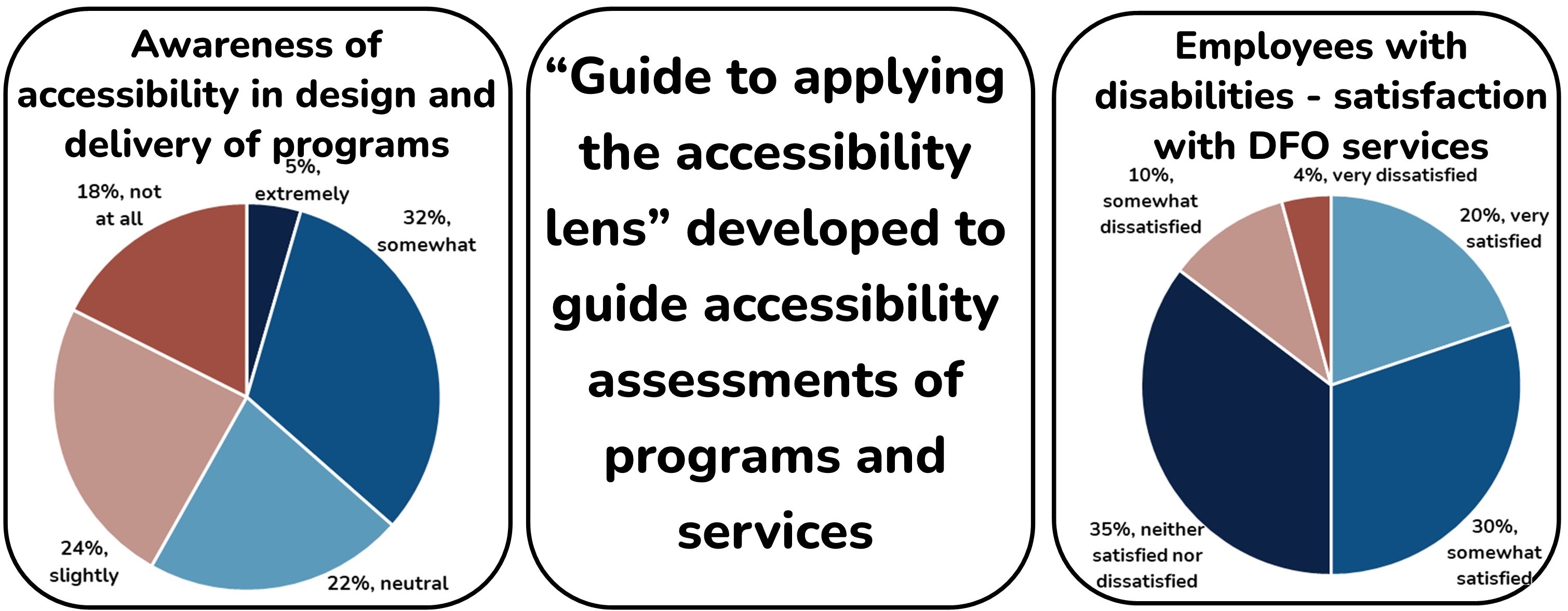
Survey findings
- Awareness of accessibility in the design and delivery of programs:
- 5% extremely aware
- 32% somewhat aware
- 22% neutral
- 24% slightly aware
- 18% not at all aware
- Employees with disabilities who are satisfied with DFO programs and services:
- 20% very satisfied
- 30% somewhat satisfied
- 35% neither satisfied nor dissatisfied
- 10% somewhat dissatisfied
- 4% very dissatisfied
- 49% of employees responding to the first annual DFO Accessibility Questionnaire reported that they were either completely or somewhat sure that they know how to think about accessibility when providing programs and services to the public
- 36% of employees responding to the questionnaire reported they were somewhat or extremely aware of accessibility considerations in the design and delivery of programs and services
Major accomplishments
To increase knowledge regarding designing and delivering accessible programs and services:
- the Guide to Applying the Accessibility Lens to Policies, Guidelines, Programs and Services (available only on the DFO network) has been developed, in consultation with persons with disabilities which will also provide directions and a structure for carefully looking at all policies, guidelines, programs, and services to proactively identify barriers
- microlearning offered by the Canada School for the Public Service was identified and made mandatory for all employees
To address inconsistently accessible programs and services, the Accessibility Action Plan calls for the regular assessment of all policies, guidelines, programs, and services to proactively identify barriers.
To support this work sectors and regions were asked for their input in creating committees to organize the work described in the Accessibility Action Plan including:
- collecting and studying data about accessibility at DFO
- sharing expertise on various priority areas
- coordinating the work to support one another
See Annex 1 for progress towards the specific goals related to design and delivery of programs and services outlined in the Accessibility Action Plan.
Next year
The advisory committee for accessibility at DFO will begin meeting. In late 2023 and early 2024, program analysts will receive training on how to assess accessibility so that programs and sectors can conduct assessments for all policies, guidelines, programs, and services they are responsible for.
Transportation
Snapshot of 2022 to 2023
- The department is aware of gaps in barrier-free access to parking at federally owned and leased workspaces and public-facing spaces, and is conducting accessibility assessments, which will continue into 2024 to 2025
- The ability to report on rates of accessibility for transportation has not yet been developed
Major accomplishments
A Real Property accessibility action plan has been approved, which will address the transportation goals.
See Annex 1 for progress towards the specific goals related to transportation outlined in the Accessibility Action Plan.
Next year
DFO will begin an accessibility assessment of parking available at departmental workspaces and public-facing spaces to identify opportunities to make them more accessible and inclusive for everyone.
Consultations
Bi-weekly meetings between the Accessibility Secretariat and the Chair of the grassroots Accessibility Network allow for opportunities to collaborate, discuss potential accessibility concerns, and maintain an open discussion on accessibility. These discussions and consultations contributed to the actions underway, and results achieved to date. Feedback received from both the network and a focus group of PwD are reflected within.
The purpose of the focus group was to collect feedback on the draft report. The meeting took place on August 31, 2023, and included persons with disabilities from regions and sectors across the organization. The 86 members of the Accessibility Network were invited to provide further feedback through their preferred method of communication. Finally, the Accessibility Network Chair reviewed the final draft of the report.
What we heard from consultations
What is working
- PwD appreciate the accessibility information and resources that have been developed, and we should actively promote them
- The GC Workplace Accessibility Passport is working well for some employees with disabilities who have supportive managers
- The Accessibility, Accommodation and Adaptive Computer Technology lending library, accessed through the DFO Disability Management team, is valuable
- There has been a change in attitude towards accessibility at DFO noticed by some participants
Barriers
Barriers reported in the consultations focused on:
- staffing processes designed to be more accessible may be creating new barriers
- formatting of texts, including using color to show meaning
- the need for continued discussion and action on gender-neutral washrooms (for example, should accessible and gender-neutral washrooms be separate spaces)
- difficulties in obtaining sign language interpreters for in-person meetings in the office
- ongoing issues with physical barriers in DFO facilities (the built environment)
Further Work
Suggestions for further work included more promotion of the GC Workplace Accessibility Passport and improved awareness of accommodation options.
Feedback
As required by the Accessible Canada Act, the departmental accessibility feedback process was carried out to obtain feedback concerning our Accessibility Action Plan, experiences of accessibility with or within the department, or any other matter related to accessibility.
The feedback received
From January 1, 2023, to September 20, 2023, the secretariat received a total of 66 submissions, 25% of which were received anonymously.
62% of the submissions were received via email, and the remainder through the online feedback form. None was received by phone, mail, TTY teletypewriter, or any other method.
Only two were received from individuals who were not DFO employees. The lack of feedback from external persons may indicate that more promotion of accessibility and the feedback process outside of the department are required.
Information received through the feedback process
Of the 66 submissions received, the Accessibility Secretariat received 28 reports of barriers, 27 of which were received from employees of DFO.
Also, DFO received feedback (30) related to the common hybrid work model, recommendations for accessibility improvements, and requests for information about accessibility.
Some of the feedback received show that people might not understand what a barrier is. This shows that more work to raise awareness about the types of barriers is needed, even among persons with disabilities.
Information received through other channels
Apart from the official feedback process, the Accessibility Secretariat has obtained feedback informally, for example via social media platforms such as Viva Engage, and formally, by conducting the first annual Accessibility Questionnaire of DFO employees.
The questionnaire was designed to assess employee awareness about accessibility in the workplace and how confident they feel about it. It also collected information about the experiences and attitudes of employees with disabilities. We collected responses from 1,682 employees out of around 14,000, which is about 12% of the total DFO workforce.
Of the employees who completed the questionnaire, 38% self-identified as persons with disabilities, and 50% of them reported experiencing barriers.
See Annex 2 for more detailed information about kinds of barriers reported through the feedback process and other channels.
How the organization has considered that feedback
DFO values feedback and aims to respond quickly. We acknowledged all feedback within 5 business days. We established a network of contacts in functional areas within the department to provide subject matter expertise and to take responsibility for eliminating or mitigating the barriers identified.
To date, 57% of the barriers identified have been addressed, 25% are unresolved, and the remainder are under review. Those that are still under review are largely issues with the built environment or technologies that will require more time to address, and support from Public Services and Procurement Canada (largely due to complexity and cost). We remain committed to removing barriers as they are identified.
How we are addressing barriers
Attitudinal barriers are being addressed by:
- continued efforts to reduce stigma and raise awareness
- communicating consistently the organizational commitment to eliminating barriers
- referring employees to the services of Disability Management and, where necessary, the Ombuds or other employee resources
Organizational barriers are being addressed by:
- asking sectors responsible for the processes that have these barriers to take actions to remove them by undertaking the accessibility analysis of policies, guidelines, programs, and services as outlined in the Accessibility Action Plan strategy to identify barriers within the design and delivery of programs and services
Physical barriers are being addressed by:
- asking the sector responsible for Real Property to take measures to remove the identified barriers
- assessing the built environment, as outlined in the Accessibility Action Plan, to make sure people can access and use them without issue, and to help us decide which barriers to focus on first and remove these
- investing in supporting individual accommodation requests effectively and efficiently
Technological barriers are being addressed by:
- asking the sector responsible for technology to take measures to eliminate the identified barriers and this has resulted in more than half being removed so far
- assessing the accessibility of information and communications technologies, as outlined in the Accessibility Action Plan strategy, and ranking these issues for action
Communications barriers are being addressed by:
- raising awareness about accessibility through various channels
- establishing mandatory training on accessible communications
- developing guidelines for creating accessible documents
Common themes emerging from the feedback received
Some common themes emerged from the feedback received. For further discussion of these themes, see Annex 2.
- Self-identification recorded in the MyGCHR application does not accurately reflect the current number of persons with disabilities employed at DFO
- Employees are not consistently reporting barriers
- The implementation of the Common Hybrid Work Model affected persons with disabilities differently than other employees
- Negative attitudes towards disabilities and accommodations still exist among managers
Conclusions and lessons learned
During the first year of putting the DFO accessibility plan into action, tremendous progress has been made. Accessibility is now top of mind and more and more at the forefront of how we deliver our programs and services. Certainly, as an organization we have learned a lot, particularly through the engagement of our managers and employees, including those with disabilities. Feedback has been instrumental in shaping our action plan, which remains evergreen, and continues to drive us towards creating a fully accessible organization for our workforce and Canadians overall. Key observations that will help DFO elaborate future accessibility actions include the following.
Eliminating barriers can be complex
Over the course of the first year responding to reports of accessibility barriers, DFO has successfully eliminated a variety of issues, while continuing to make progress on barriers with greater complexity that require deeper intervention.
Here are some examples of situations where barrier mitigation continues to require further intervention.
- Changes to the built environment, in particular in leased buildings
- Any changes to the built environment require coordination and approval by Public Services and Procurement Canada (who manage the lease agreements) and the building owners who must respect building codes and standards set by other levels of government
- This can at times cause delays in eliminating barriers
- Barriers requiring changes in attitude
- Significant progress has been made over the last year to promote awareness and education with respect to accessibility
- However, we recognize that it will take time for broad cultural changes across society to take hold
- Changing attitudes requires ongoing effort and we must continually work on shifting the culture to eliminate all negative attitudes
- Solutions for barriers are not the same for all PwD
- Changes that improved accessibility for one group of PwD were sometimes identified as barriers by other PwD
- Ensuring that we consult a wide variety of PwD will help us to find solutions that work for everyone
DFO remains committed to eliminating barriers and ensuring an accessible organization for all, including in the face of complex barriers. As an organization we will work collaboratively with our stakeholder networks, industry partners and central agencies, and have confidence that with every step, we will together overcome existing and emerging challenges. For example, participating in interdepartmental forums would improve coordination between departments to eliminate barriers at the outset or implement solutions more effectively. As a next step, we will be working with the Office of Public Service Accessibility (OPSA) to share our insights and recommendations based on what we have learned to date.
Additionally, we expect that best practices will evolve over time and that we will benefit from the experience of everyone in the public service consulting with PwD and working to eliminate barriers, as well as guidance from lead departments. We look forward to the work of Accessibility Standards Canada to establish standards and best practices based on broad public consultations.
Awareness and education are critical
We have learned that we cannot underestimate the effort required to make cultural changes within a large department. Although our departmental plan has very specific actions and goals that require significant engagement including the implementation of education and awareness activities, further emphasis will be made in this area in the coming year to accelerate cultural change.
Awareness and education are critical to the successful implementation of the department plan, specifically the comprehensive, proactive and systematic identification of barriers across the 7 priority areas, each of which will have a profound change to accessibility at DFO.
Data for measuring progress is essential
DFO is committed to gathering data, tracking this, and reporting transparently on progress towards our goals. To do so, establishing data availability as well as understanding where data gaps exist is imperative. We need to ensure that we have appropriate data sources for measuring progress. For example, based on guidance provided by the Office of Public Service Accessibility (OPSA) on reporting on employment processes, we are working to create methods to collect the required data that will better allow us to proactively identify barriers to employment of PwD.
We also identified that some key measures of progress are required to easily track how well we are doing. We have developed 5 indicators which are described in Annex 3.
Accommodations are an integral component of accessibility
The processes for obtaining accommodations and the attitudes of managers in providing accommodations was a theme within the feedback. This was echoed in the Study of Causes and Impacts of Harassment and Discrimination of Persons with Disabilities in the Federal Public Service prepared for the Office of Public Service Accessibility (PDF 925 KB) in which they found that harassment and discrimination tended to arise in the context of accommodations.
To deal with the report's findings, the accessibility champions sent messages to front line managers to draw attention to the study and to the specific actions and attitudes managers can take to improve in this area. Additionally, work on a government-wide platform for the GC Workplace Accessibility Passport will be helpful.
DFO will continue to drive action towards reducing the time it takes to accommodate employees so they may fully participate. Efforts include, establishing an accommodation framework that identifies key stakeholders in the delivery of accommodation services, establishing service standards and tracking compliance with these, ensuring funds are available and developing specific feedback mechanisms. The development and implementation of these measures will be undertaken collaboratively with networks and bargaining agents. Further education for managers and employees will be offered as well as training for those delivering the services.
As an organization, we remain committed to ensuring the full participation of not only our workforce but of Canadians as they engage with our programs and services. We are dedicated to creating and maintaining a culture of inclusion, which recognizes the value that accessibility brings for us all when it is woven into all that we do.
Annex 1: Progress towards the specific goals of the Accessibility Action Plan 2022-2025 – Shaping our Accessible Future
The Accessibility Action Plan 2022-2025 includes goals and specific strategies to achieve them. The list of goals below shows the work that has been done to carry out these specific strategies.
Employment
Goal: E.1 Employees are aware of accessibility considerations in employment
- A baseline for awareness about accessibility in employment has been established against which to measure future progress
- Information about accessibility in employment was communicated through a variety of channels including the accessibility in staffing section in the Accessibility Secretariat’s intranet site
- Mandatory training on Inclusive Hiring Practices was introduced and promoted to all supervisors, managers, executives as well as staffing advisors
- Employment equity and talent acquisition training was provided to managers and human resources business partners
Goal: E.2 Improve hiring, promotion and retention of persons with disabilities
- Recruitment campaigns targeting EEDI candidates, including persons with disabilities (PwD), such as All Hands on Deck, All Hands on Science, and Recruitment of Policy Leaders are underway
- Accessibility features and considerations were integrated into our All Hands on Deck recruitment process
- Began prioritizing employment equity candidates in externally advertised hiring processes and working with partners to focus on hiring people with disabilities
- DFO actively participates in the Mentorship Plus Learning Lab-Sponsorship Program, dedicated to helping employees at the EX-01 and EX minus 1 levels who self-identify as part of equity-seeking groups, such as persons with disabilities, to help them advance in their careers
- As of March 2023, DFO has 4 participants in the program who self-identify as PwD
- In 2022, the number of Talent Management Plans (TMP) for PwD was 35 as compared to 14 in 2021
- This year, the department’s sponsorship program has made progress by including 5 employees who self-identified as PwD
- In the 2 years prior, no employees had self-identified
Goal: E.3 Employees have barrier-free access to employment and are supported and able to contribute to the department
- Work on the multi-year commitment to conduct accessibility assessments of hiring procedures at DFO has begun
- Accessibility and accommodation measures are being promoted throughout the hiring processes
- Onboarding packages have been updated with accessibility information
Return to the Employment section
Built environment
Goal: B.1 Employees are aware of accessibility considerations in the built environment opportunities
- A baseline for awareness about accessibility considerations in the built environment has been established against which to measure future progress
- Mandatory training on Accessibility in the Built Environment was introduced to all employees responsible for program and service design and delivery
Goal: B.2 Clients and employees have barrier-free access to and use of the federally owned and leased built environment and workplaces
- Regions have put into action the approved plan to undertake accessibility assessment of the built environment
- A checklist for assessing accessibility has been drafted
- Ranking of buildings to be assessed has started
- Accessibility features and services offered in workspaces, such as those at the new building at 222 Nepean in Ottawa, are being promoted in departmental communications with employees
Return to the Built environment section
Information and communication technologies
Goal: I.1 Employees are aware of accessibility considerations in information and communication technologies (ICT) opportunities
- Ongoing learning is happening for the Chief Digital Officer’s (CDO) team about the importance of including a diverse group of people in the research process when creating products to ensure that our products are naturally designed to be accessible to everyone
- Plans are in place to expand this learning to employees outside of the CDO sector
- Our IT staff have received training on Accessibility, Accommodation, and Adaptive Computer Technology (AAACT) based on the recommendations from the AAACT program within Shared Services
- Mandatory training on Procuring Accessible Information and Communication Technologies has been assigned to all employees working in IT
- The UX team is collaborating with teams across CDO sector to ensure accessibility criteria are properly shown in digital service contracts
Goal: I.2 Clients and employees have access to information and communication technologies that are barrier-free
- The CDO sector is implementing a dedicated User Experience (UX) unit specializing in digital accessibility to research, design, and test digital products with accessibility in mind to ensure that digital products and services are easy to use for everyone, especially PwD
- The UX team is collaborating with teams across CDO sector to ensure accessibility criteria are properly reflected in digital service contracts
- The Departmental Architectural Review Board is establishing accessibility as a pillar for technology assessments
- The UX team tests digital products to ensure they meet the proper accessibility criteria and they have tested the following for accessibility:
- the Enterprise Data Hub
- the Mental Health Support Launchpad
- the Registry for External Science Experts
Goal: I.3 Employees with disabilities have barrier-free access to tools and technologies
- Senior managers are being told to take charge of paying for accommodations their staff need, so that cost is not a barrier, and details have been made available in The Guide on the Duty to Accommodate and shared through other messages
- Assistant Deputy Ministers, Deputy and Assistant Commissioners and Regional Directors General are aware of this mandate through communications between members of the Departmental Management Committee
- The Disability Management team is in place to provide advice and guidance to managers and help with the acquisition of accommodations, including technological tools and there is a proposal to expand that team
Return to the Information and communication technologies section
Communication, other than information and communication technologies
Goal: C.1 Employees are aware of accessibility considerations in communication
- A baseline for awareness about accessibility considerations in communications has been established against which to measure future progress
- Communication about accessibility is being shared through:
- a dedicated webspace
- messages from the departmental champions
- the departmental newsletter
- direct messages
- Mandatory training was introduced to make certain that employees and managers have the skills to create accessible MS Word and MS PowerPoint documents
Goal: C.2 Clients and employees have barrier-free access to all communication
- An action plan for ensuring the accessibility of web content has been developed
- General advice on creating accessible communication products has been created in discussion with persons with disabilities and has been promoted to all staff
- Our web team has been trained to review our web pages for accessibility and correct any issues found
Goal: C.3 Reduce stigma associated with accessibility
- Our departmental accessibility champions played an important role in reducing stigma throughout 2023 by:
- supporting the Accessibility Network of DFO employees with disabilities and their allies
- promoting days of recognition related to accessibility, such as the International Day of Persons with Disabilities and other days, highlighting different disability communities
- launching an accessibility campaign to educate and inspire a culture change within the department
- celebrating National AccessAbility week with communications and events that promoted education about different kinds of disabilities
- The GC Workplace Accessibility Passport was promoted throughout the department through various communications channels
Return to the Communication section
Procurement of goods, services and facilities
Goal: P.1 Employees and contractors are aware of accessibility considerations in procurement
- Microlearning offered by the Canada School for the Public Service was identified and made mandatory for all employees
- Information sessions, developed by the department, have been established and are provided to DFO staff on a monthly basis
- Maritimes region offered and promoted learning about accessible procurement processes
Goal: P.2 Reporting limitations are eliminated
A working group has been created to identify the report(s) and data that are available.
Goal: P.3 Solicitation documents are fully accessible and usable by persons with disabilities, and contractual language outlining Government of Canada contracting responsibilities with respect to accessibility in procurement is added
Updates to template documents ensuring that they are accessible and respect elements outlined by Shared Services Canada’s Accessibility, Accommodation and Adaptive Computer Technology Program are underway at Public Services and Procurement Canada.
Return to the Procurement section
Design and delivery of programs and services
Goal: D.1 Employees are aware of accessibility considerations in design and delivery of programs and services
- Microlearning offered by the Canada School for the Public Service was identified and made mandatory for all employees
- In-house training on assessing policies, guidelines, programs, and services for accessibility was developed, and will be offered in 2024
Goal: D.2 Clients and employees have access to programs and services that are barrier-free
- The Guide to Applying the Accessibility Lens to Policies, Guidelines, Programs and Services (available only on the DFO network) was developed and published as the first step in beginning the accessibility assessment of all policies, guidelines, programs, and services to identify how the department can be more accessible, inclusive, and comply with new accessibility standards
- A framework was developed and published to allow for the filing of a record of consideration for accessibility and justification for inclusion or non-inclusion for all policies, guidelines, services, and programs
Return to the Design and delivery of programs and services section
Transportation
Goal: T.1 Employees are aware of accessibility considerations in transportation
The creation of trial information sessions is underway.
Goal: T.2 Clients and employees have barrier-free access to parking available at federally owned and leased workspaces and public-facing spaces
- Draft parking guidelines and a review of the parking policy is underway
- A checklist for assessing parking accessibility is under development
Goal: T.3 Employees have barrier-free access to transportation in order to accomplish their work
Canadian Coast Guard is considering accessibility in vessel design through the Fleet renewal and procurement process. For example, console layouts, seating arrangements, and windscreen construction of newest class of Search and Rescue lifeboats were redesigned to take into consideration different physical requirements.
Return to the Transportation section
Annex 2: Information about the kind of barriers reported through the feedback process and through other channels
Return to the Feedback section
The kinds of barriers reported through the feedback process
5 were attitudinal barriers, mostly related to lack of manager support and obtaining acceptable accommodations.
7 were organizational barriers, related to:
- staffing practices
- the common hybrid work model
- accommodations processes
- the gap between bereavement leave and disability benefits for those suffering from mental anguish due to bereavement
All of these have been addressed (see How we are addressing barriers) except for one which is still being reviewed.
12 were physical barriers, mostly related to:
- specific absences of accessibility features in particular buildings
- access to accessible and gender-neutral washrooms
- accessible parking
4 of these have been addressed (see How we are addressing barriers), the rest are still being reviewed.
7 were technological barriers, related to:
- computer peripherals
- problems with accessibility in the departmental security software
- difficulty in the use of accessibility features on various platforms
5 of these have been addressed (see How we are addressing barriers), the rest are still being reviewed.
1 was a communications barrier, related to the use of acronyms in documents.
This has been addressed (see How we are addressing barriers).
The kinds of barriers reported through the employee experience questionnaire
- Attitudes (26%) - how people treated those with disabilities, for example having biased opinions or being prejudiced
- Policies (25%) - how policies affected persons with disabilities (PwD) differently, for example, an accepted way of doing business that hinders the full and equal participation of PwD
- Physical obstacles (17%) - having to do with the built environment, for example, lack of automatic doors or low lighting
Return to the Feedback section
Common themes emerging from the feedback received
Self-identification does not accurately reflect the number of persons with disabilities employed at DFO
Only 56% of employees with disabilities who completed the questionnaire have self-identified using the departmental Human Resources Management System (HRMS) or the self identification form, suggesting that the information in the HRMS may not correctly show the numbers of PwD in the department.
Persons with disabilities responded most often that they didn’t self-identify formally because they felt it might negatively affect their career, or the way colleagues and managers treated them.
It is a known problem that the current form for self-identification needs to be improved. Employees might not find options that match their situations in the form, and there is evidence that employees are not completing or updating the self-identification information on file every time they switch Government of Canada departments.
This information tells us that we need to do more to make people with disabilities feel confident that we won't share their information with their colleagues or managers. We also need to find a better way to collect this information. The Treasury Board Secretariat is working on a new form and platform that will securely collect self-identification data independently from the department, which should make the information more accurate.
Employees are not consistently reporting barriers
Only 31% of employees with disabilities who experienced barriers reported them. Others didn’t report the barriers they experienced because:
- they didn’t think it would make a difference, or reporting barriers in the past didn’t make any difference (35%)
- they didn’t know how or didn’t think there was a way to remove the barrier (27%)
- they didn’t want to identify themselves as a person with a disability (20%)
The majority (63%) of employees who reported barriers informed their managers or supervisors. Only 2% reported the barriers they experienced to the Accessibility Secretariat. 47% said the barriers they reported remain unresolved. This information suggests that employees and managers are not yet aware of the role of the Accessibility Secretariat.
The implementation of the Common Hybrid Work Model affected persons with disabilities differently than other employees
The impact of the implementation of the Common Hybrid Work Model and the return to the workplace was different for persons with disabilities than for persons without disabilities. Employees reported that, at home, they were able to design their work environment to meet their own needs. In the workplace, it took effort and persistence to obtain the accommodations they had at home. As persons with disabilities often have limited energy, some felt that coming to the office “used up” energy that could have been spent at work or in their personal lives. They also felt better able to control their privacy about their disabilities. Finally, mandatory in-person meetings created barriers for some employees. Given the emphasis that the senior leadership of the public service put on ensuring employees returned to the workplace, front line managers may have thought that the requirement to return to the office was more important than the need to accommodate employees with disabilities.
In order to address this issue, we provided managers guidance on how to handle accommodations and made sure that people with disabilities weren't unfairly affected by the new hybrid work model. Managers received this information from the departmental accessibility champions.
Negative attitudes towards disabilities and accommodations still exist among managers
Some employees found it hard to get the accommodations they needed because their managers:
- were uncooperative, had negative attitudes, and used negative language when employees requested accommodations, including using words like “laziness”
- demanded and/or shared copies of the GC Workplace Accessibility Passport without the employee’s consent
- asked for more medical information than necessary
- made employees go through a lot of complicated steps to prove that they needed the accommodations
The work to ensure that all managers understand their roles in accommodating their employees with disabilities is critical. While the Accessibility Action Plan addresses promotion of the GC Workplace Accessibility Passport, and general ideas about stigma and inclusion, it does not specifically address obtaining accommodations as a barrier to allowing persons with disabilities to participate fully to their best potential. This should be included in the next Accessibility Action Plan in 2025.
Return to the Feedback section
Annex 3: Simple markers of progress on accessibility
To make sure we are improving, we developed 5 markers to track overall progress as we go forward.
Representation: Are we closing the gap in representation for persons with disabilities (PwD) at DFO?
Ideally, the percentage of PwD at DFO would be at least as high as the availability of PwD in the workforce. This would appear as a representation gap of zero employees.
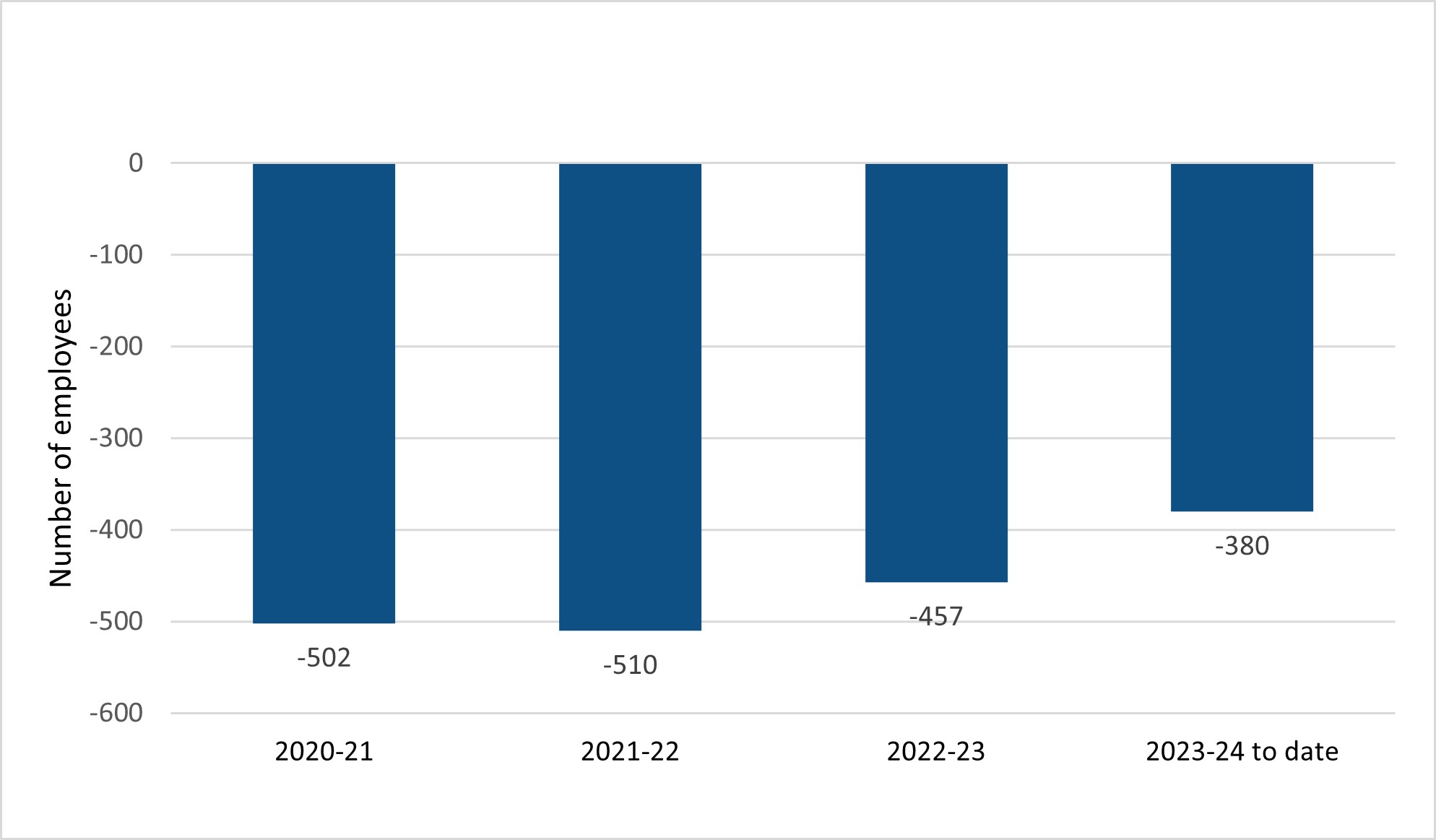
Source: DFO HR Data Bank reporting data from the DFO Human Resources Management System.
Figure 11 - Text version
Gap between number of PwD at DFO and the number expected at DFO based on availability in the workforce:
- 2020 to 2021: -502
- 2021 to 2022: -510
- 2022 to 2023: -547
- 2023-2024 to date: -380
Promotion: Are PwD promoted as often as others in the DFO workforce?
Ideally, PwD would be promoted at the same rate as everyone else and this would appear as a difference of zero.
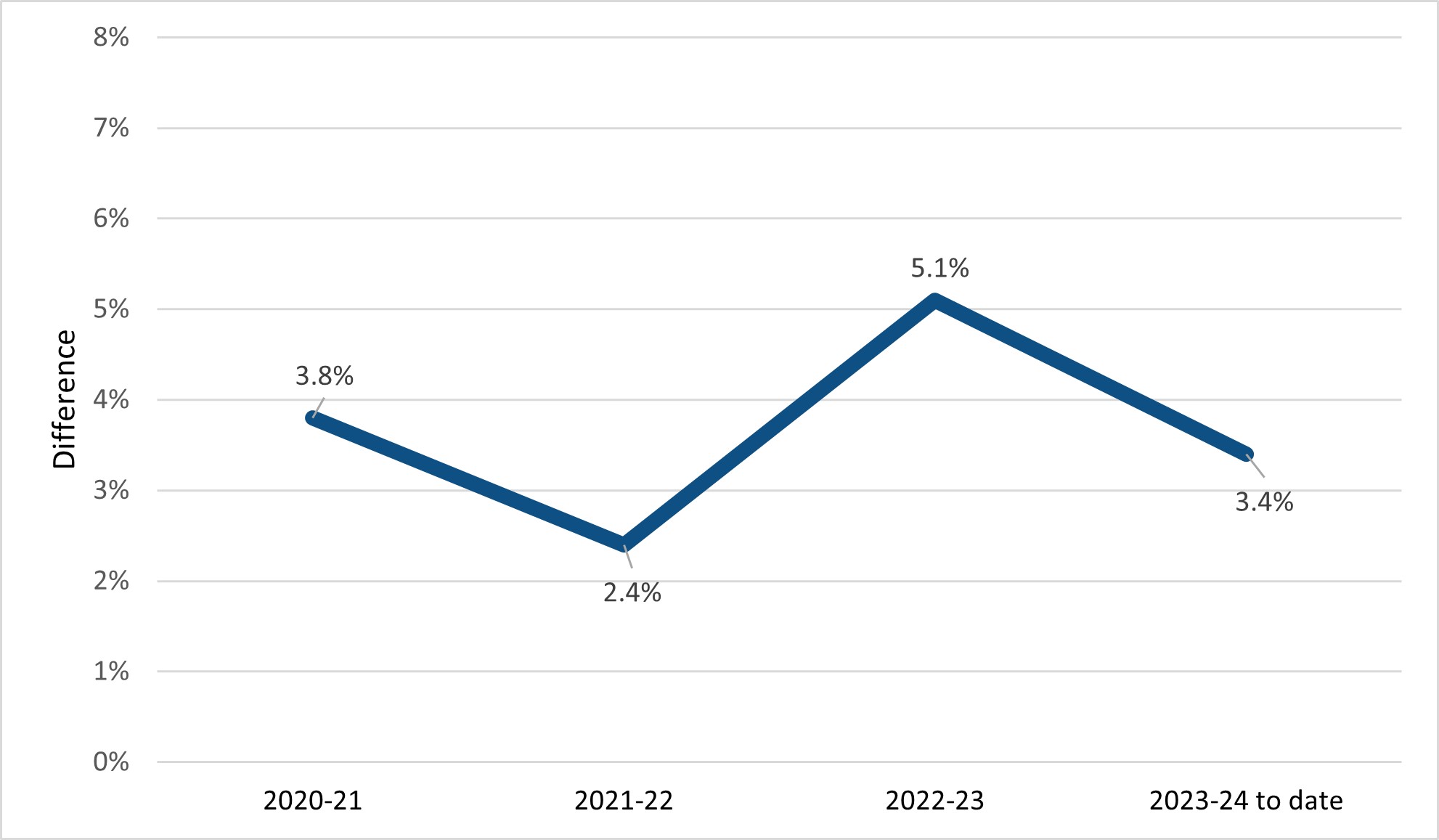
Source: DFO HR Data Bank reporting data from the DFO Human Resources Management System.
Figure 12 - Text version
Difference between the rate of promotion of persons with disabilities and the DFO workforce:
- 2020 to 2021: 3.8%
- 2021 to 2022: 2.4%
- 2022 to 2023: 5.1%
- 2023-24 to date: 3.4%
Retention: Are PwD leaving at a higher rate than others in the DFO workforce?
Ideally, PwD would have the same opportunities and experience as everyone else and would not be more likely to leave than everyone else, and this would appear as a difference of zero.
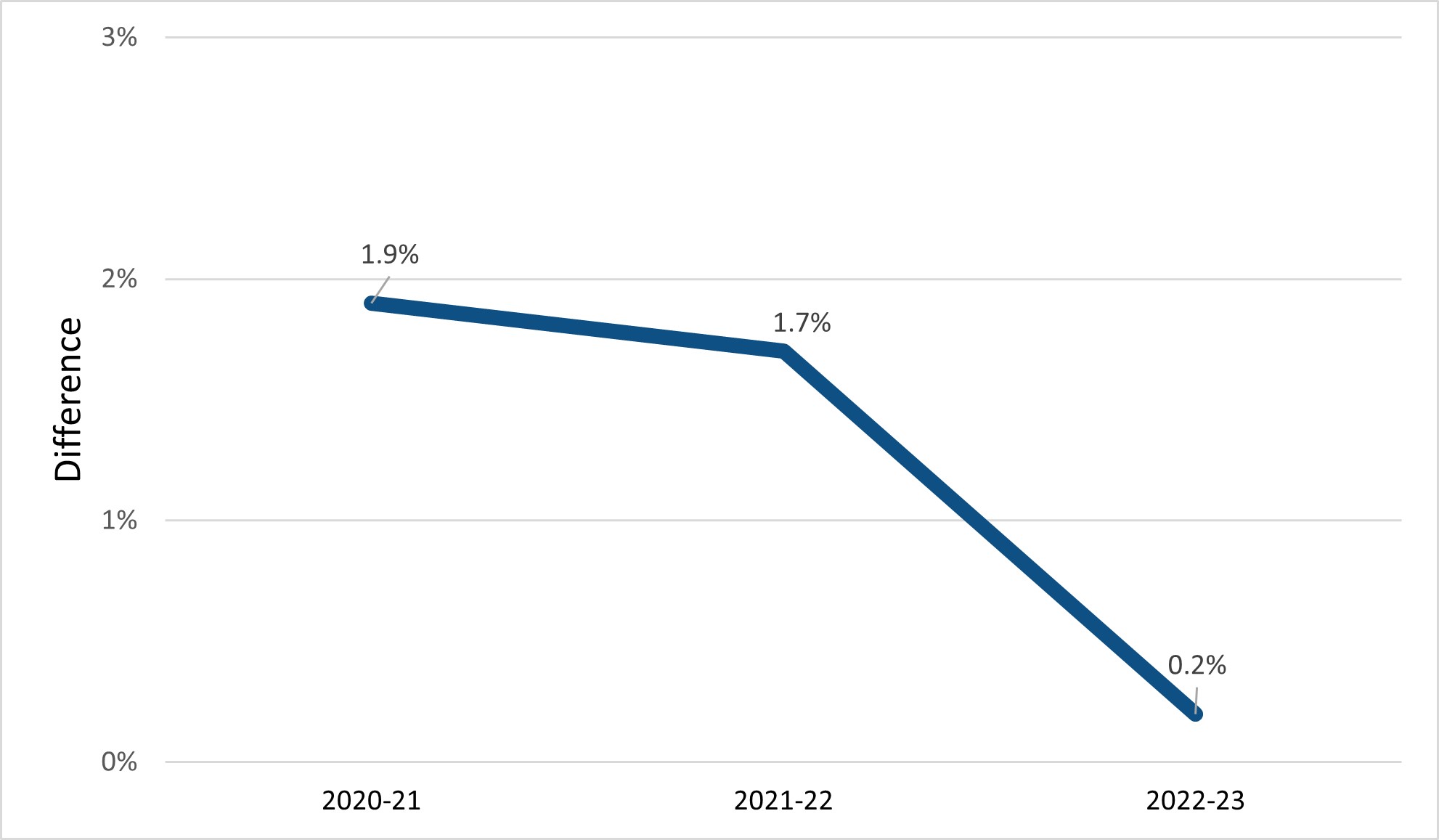
Source: DFO HR Data Bank reporting data from the DFO Human Resources Management System.
Figure 13 - Text version
Difference in rates of departure between persons with disabilities and the DFO workforce:
- 2020 to 2021: 1.9%
- 2021 to 2022: 1.7%
- 2022 to 2023: 0.2%
Inclusion: Do PwD feel they are discriminated against?
Ideally, there would be no discrimination at DFO, and this number would be zero.
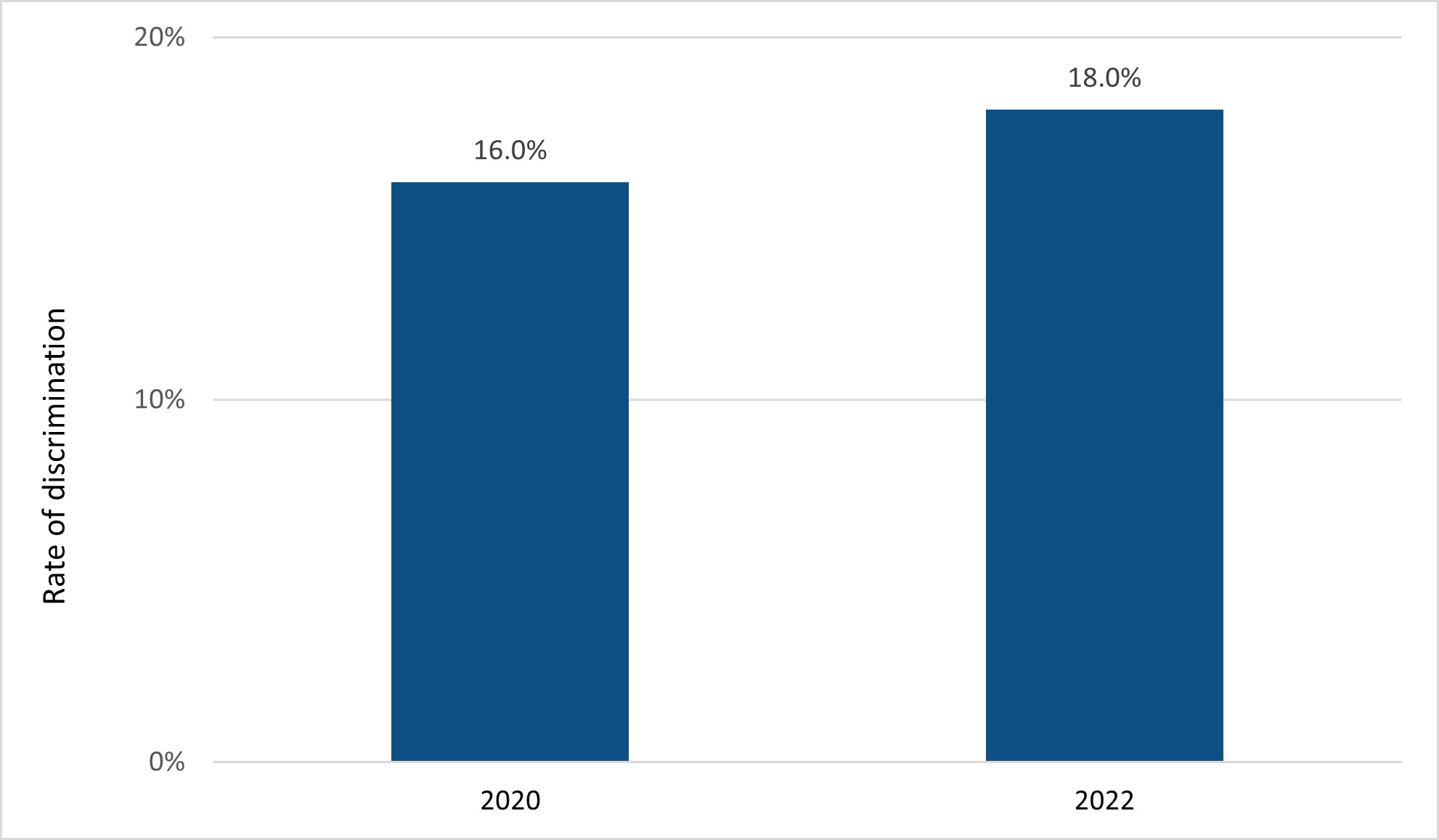
Source: Public Service Employment Survey results for PwD at Fisheries and Oceans Canada responding to Question 64: Having carefully read the definition of discrimination, have you been the victim of discrimination on the job in the past 12 months?
Figure 14 - Text version
Rate of discrimination reported by persons with disabilities:
- 2020: 16%
- 2022: 18%
Accommodations: How many PwD feel that accessibility and accommodations issues have negatively affected their career?
Ideally, anyone requiring accommodations would have them, DFO would be fully accessible and this number would be zero.
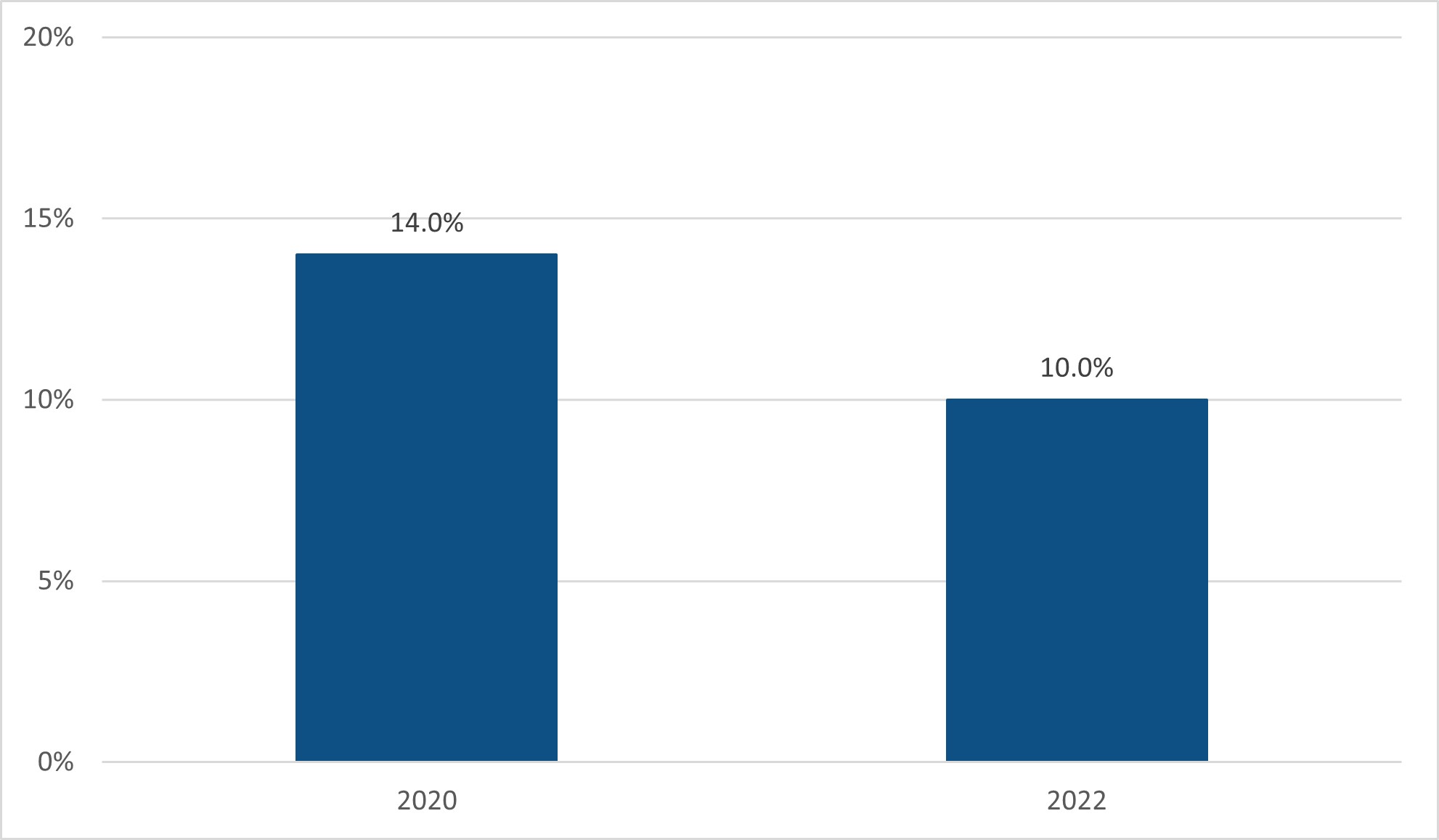
Source: Public Service Employment Survey results for PwD at Fisheries and Oceans Canada responding to Question 43d. To what extent have the following adversely affected your career progress in the federal public service over the last 12 months? Accessibility or accommodation issues?
Figure 15 - Text version
How many PwD believe that accessibility and accommodations issues negatively affected their career to a large or very large extent:
- 2020: 14%
- 2022: 10%
- Date modified: